
The Villa Hermes in Vienna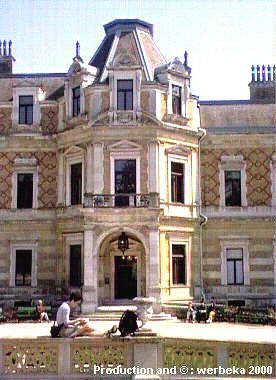 The entrance of the Villa Hermes.
The entrance of the Villa Hermes.It isn't all that easy to find your way to the Villa Hermes, if using public transport. You have to take the tram number 62 at Meidling (where Underground and Schnellbahn meet) and have to change to bus number 62A a couple of stations later. The bus will take you to the main entrance of "Lainzer Tiergarten", from where it is at walking distance, about 10 - 15 minutes away. On the other hand it was the intention of Emperor Francis Joseph I to build this hunting pavilion quite a bit outside of the city, as it was meant to be a gift to his spouse, Empress Elisabeth of Austria, or - as she is better known today - Sissy.
Elisabeth was not very fond of official court-meetings, so she tried to escape as often as possible, travelling most of the time. By building the Villa Hermes, Francis Joseph wanted to present her with an alternative to the Castle in the City and to Schönbrunn, which both had a very official touch. In a letter from 1881 the Emperor tells Elisabeth that his thought was to build a retreat for them, where they could live, when they grew older. At that time Francis Joseph was 51 years of age, Elisabeth 7 years younger. The Emperor gave the architect Carl von Hasenauer the order to plan the building and in the following year the actual work began. In 1886 the villa, including all the surrounding buildings, like the riding-school for the Empress, was finished. Because of the Emperor's conservative and simple style of living, there was not only some contrast in the furnishment of his chambers, compared to those of the Empress, there were originally neither bathtubs nor water-toilets in the house. Both facilities were to be inserted about 10 years later on the order of Elisabeth.
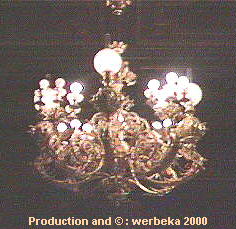 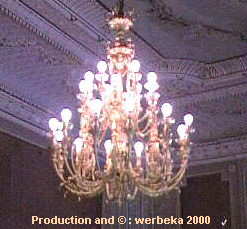 The chandeliers were all prepared for electric light. Electricity though, being planned from the beginning, became soon an outstanding feature of the Villa Hermes. There were not only no less than 120 lamps enlighting the terraces of the building, the road leading to it was one of the first in the Empire to be lit electrically.
Downstairs there was the Diningroom in a central position, whereas the archduchesses Gisela and Marie Valerie had their chambers to the left and the right of it. Upstairs there were the rooms of the imperial couple, with flair and abundance on Elisabeth's side, but much simpler to the left, where the chambers of Francis Joseph were to be found. Many of the rooms today are used for exhibitions, but in some places there is still so much left of the original furniture, that you can get a picture of what it looked like 100 years ago.
I was fascinated by the fountain on the wall of the Diningroom, which, as I read, was used for cooling beverages. Another lasting impression was the Gymnasium, which the Empress used. It is empty today, but the wallpaintings still remain. They show classical sporting scenes, like Atalante running (and picking up the golden apples) or Perseus throwing the discus, that flew so far that it (unintentionally) killed his grandfather. The Empress' Dormitory is worth a second look as well. There is the bed that was used by Maria Theresia in the 18th century and there are outstanding paintings on walls and ceiling. mainly fetched from Shakespeare's "A Midsummernight's Dream". No wonder, as Elisabeth liked to think of herself as Titania.
The Empress usually spent every year a couple of weeks in the Villa Hermes, mostly in springtime, until 1899, when she was assassinated. The heiress was to be her favorit daughter, Marie Valerie, even if Francis Joseph had the right to live there during his lifetime. After the fall of the Empire in 1918 the Villa Hermes was to become property of the "Fund for the disabled in the war" until the Republlic of Austria took over in 1937, only to give it away again a couple of years later, when the Russians, victors of the next war, ordered to empty the house. It was returned already in 1950, though. Nevertheless the building decayed in the years to come, until "The Association of the Friends of the Villa Hermes" decided to restore whatever could be saved and make the house a museum. 17.5.2000 by webmaster@werbeka.com |
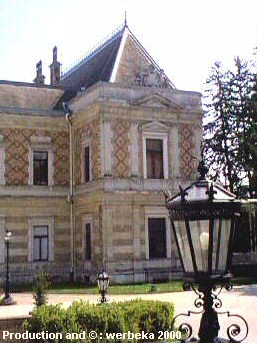 A view of the southern wing.
A view of the southern wing.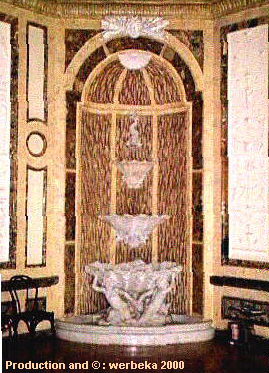 Not only pleasant, but also functional was this fountain.
Not only pleasant, but also functional was this fountain.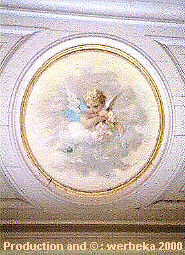 A wallpainting from the Empress' Dormitory.
A wallpainting from the Empress' Dormitory.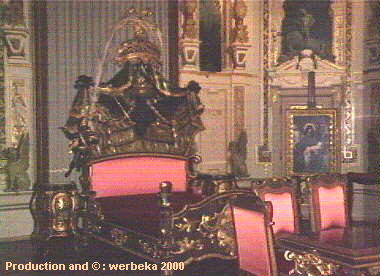 Maria Theresia, Empress 1740 - 1780, already slept in this bed.
Maria Theresia, Empress 1740 - 1780, already slept in this bed.
